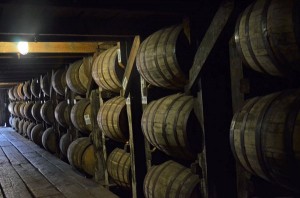By Richard Thomas
Whiskey shortages continue to figure prominently in internet forums and the news pages, as does the myth that hundreds of millions of new drinkers in China and India have suddenly cropped up and are to blame for guzzling the world’s semi-fixed supply of whiskey. The Whiskey Reviewer has already debunked the conventional wisdom that whiskey as a whole is in short supply, or that the new demand in Asia is solely to blame.
Yet it is undeniable that some brands are experiencing very real problems. Maker’s Mark stirred up a furor earlier this year by announcing it would eek out its supply by watering down its bourbon; Buffalo Trace tries to meet spiraling demand for its premium brands through rationing; and some brands have seen price spikes and repeated absences from store shelves. If the Asian thirst is not to blame for these shortages, then just what is?
1. Accidents: At the heart of the whiskey shortage storyline is one fundamental truth: since even a young bourbon or scotch needs to spend at least a few years in the barrel, supply cannot instantly catch up with demand. Compounding that truth is accidental wastage.
Spirits like whiskey are flammable, and almost every year part of the worldwide supply goes up in smoke. Jim Beam, Heaven Hill, and Wild Turkey have all experienced warehouse fires over the last 20 years, in some instances repeated fires. Fires also have burnt up whiskey warehouses in Scotland.
Spills also eat into the general whiskey supply. Sometimes these spills are shipment wastage, like when a truck lost 7,000 gallons of Canadian Club in Kentucky in 2009. Yet sometimes the spills take place at the source, such as when Chivas Regal famously dumped almost 5,000 gallons of its aged product into the sewer earlier this year. Natural disasters play a roll too, such as when a tornado tore the roof off a historic warehouse at Buffalo Trace (which also fortuitously gave us the wonderful Colonel E.H. Taylor “Tornado” Bourbon).
Some whiskey is destroyed through sheer happenstance every year, and while an accident or disaster might destroy only a tiny fraction of a distiller’s inventory, that fraction can be very important on down the line. When Maker’s Mark tried to cut down their whiskey, some observers commented it would only expand the supply by a few percentage points, and that’s about the same as gets lost in the typical warehouse fire.
2. Demand: Whiskey demand is on the rise, and has been for more than a quarter century now. Recently the demand for American whiskey seems to be accelerating yet again, with overall sales rising 3.5% in 2011 and 5.2% in 2012. The sales rate for scotch is more erratic, but has been generally trending upwards in recent years, while Irish whiskey is positively booming.
The falsehood in the spiraling demand story is not that rising demand is outpacing supply, but that the demand is mostly or entirely in Asia. Scotch sales in China are actually slumping right now, so much so that they drag down the worldwide numbers, while India has a very large domestic distilling industry supplying its needs. Furthermore some of the new demand comes from Eastern Europe and South America, and a big chunk of it comes from within the old markets in the United States, Japan, and Western Europe.
3. Skewed Priorities and Poor Planning: What some in the whiskey industry don’t want you to know is that some of the shortage issues are due to their own business decisions. The scotch industry first started seriously pushing single malts in the early 1980s, and the bourbon industry began introducing small batches and single barrels in the mid-to-late 1980s. The whiskey boom started there, and in the long view sales have steadily risen ever since. Yet some whiskey makers continued to push their sales while failing to invest in expanded production.
For example, Jim Beam has been on a major acquisitions campaign in recent years. They bought DYC in Spain and closer to home they bought Maker’s Mark. Months before Beam bought Maker’s, Maker’s announced a plan to duplicate it’s successful 1996 expansion, thereby increasing production capacity by 50%. After the acquisition, the expansion of Maker’s production capacity was lost in the transition, and even in the midst of the intense press coverage given to Beam’s plans to stretch it’s supply of Maker’s Mark by first watering it down, and now through barrel washing, the idea of expanding Maker’s production capacity has yet to be revived.
Meanwhile, Beam’s march of acquisitions goes on. Beam spent $95 million to buy Cooley last year. They bought Two Gingers Irish Whiskey that same year, and Skinnygirl Spirits the year before. Clearly Beam can raise plenty of cash. They just choose not to spend it on plumping up Maker’s Mark’s production capacity.
 The Whiskey Reviewer A World of Whiskey, Poured Every Weekday
The Whiskey Reviewer A World of Whiskey, Poured Every Weekday




thanks for sharing